If you want to know about the Egyptian architecture or Indus valley civilization or evolution of Hindu temple architecture, please click the link.
Roman architecture is a style of architecture that developed in ancient Rome and was used throughout the Roman Empire. It is characterized by the use of massive concrete structures, such as the Colosseum and the Pantheon, as well as by the use of the arch and the dome.
The beginning of roman civilization was contemporary with that of the Greeks, the Etruscans, and later Egyptian dynasties. Unlike all of these cultures however, Rome continued to grow in importance by the end of 1000BCE, reaching its apogee in 100 & 200 CE. In time Rome absorbed the Etruscans, Greeks, Egyptians, and many other lesser peoples and formed an empire with a remarkable homogenous architectural style.
The rise of ancient Roman architecture coincided with the rise of the Roman Empire. The Romans had a sound knowledge of architecture and building materials – they particularly excelled in the use of concrete and arches – and some of the structures they built are still standing in the present age.
1) Introduction
- Roman architecture was a combination of Greek and Roman culture
- The Greek temples with columns all around was fused with the Roman front-facing temple built on a high podium
- Ancient Rome emphasized the use of columns in their architecture
- The columns were utilized as a support and decoration. The Romans came up with five different types of columns, which are the Tuscan, Doric, Ionic, Corinthian, and Composite. Most of these, however, were adopted from Greek columns.
- The architectural technique of the arch and column is a trademark of Ancient Rome.
- The Romans applied the arch to many of their buildings
- Two of the first structures to carry arches are bridges and aqueducts. Triumphal arches were later constructed to honor their leaders, and vaults came into practice, which are arched roofs.
- Distinctive Roman manner of building, sculpting and painting emerged in 2nd century BC.
- They became more exposed to other artistic cultures, notably that of Greece as they began to expand throughout Italy and the Mediterranean.
- Patrons are not just the emperors, senators, and the aristocrats, but of all the peoples of Rome‟s vast empire including middle-class businessmen, freedmen, slaves and soldiers.
- Roman Architecture was eclectic because of the extraordinary geographic extent of patrons.
- Cohesive factor through all the differences was the Roman character i.e. the ability to organize in large and complex terms, politically, architecturally, or otherwise.
- Modern knowledge of Roman architecture derives primarily from studies of architectural remains scattered throughout the empire.
- Another source of information is a vast store of records, including dedicatory and other inscription on public works.
- The end of Roman arts and the beginning of Medieval architecture is usually said to occur with the conversion of the Emperor Constantine the Great to Christianity on AD330.
- Roman styles continued however in Christian guise onto later civilization.
2) Architectural influences
Geographical
- Much of the country is mountainous but not broken up into isolated city-states as in Greece.
- Rome has a central and commanding position in the Mediterranean Sea.
- While the Greeks were seafaring people, Romans extended their influences by conquest or annexation
- Roman Empire was not confined geographically to Italy but included all those parts of north-western Europe, North Africa and Western Asia. (Spain, Britain, Germany, Syria, Romania and North Africa).

Geological
- Romans had iron , copper, and tin, terracotta and brick in addition to stone and marble of the Greeks.
- they had various building stones such as tufa (with varying degree of hardness); peperino; travertine (hard limestone from Tivoli); besides excellent sand and gravel.
- the building material which led to great structural innovations was concrete formed of stone or brick rubble and a mortar of which the most important ingredient was pozzolana (a volcanic earth).
- white and colored marbles imported from all parts of the empire were also used extensively.
- Despite abundance of varying building materials in regions under its control, concrete, in conjunction with its brick or stone facings was the favourite material, which helped give uniformity of style throughout the empire.
Climatic
- Due to the wide expanse of the empire, there were varieties of climatic conditions.
- North Italy has the climate of the temperate region of Europe; central Italy is genial and sunny, while the south is almost tropical.
- This variety of climatic conditions account for diversity of architectural features and treatment, and produced local modifications in details, yet the Roman architectural character was so pronounced and assertive as to leave little choice in general design.
Religious
- They had a polytheist religion which was a fusion of several gods.
- roman gods acquired similar attributes to those of the Greeks but retained their Latin names and rites.
- The religion of ancient Rome under the priest class acting as apparatus of the state, soon became part of the constitution of the state.
- The emperor ultimately received divine honours and was described as the head of all varieties of deities under the widespread Roman rule.
- Dissatisfaction with state religion showed itself from time to time.
- Every family had an altar to the family gods (Lares) and ancestor worship was a recognized art of religious rites.
- Despite periodic persecution, Christianity increased in its appeal, and it became sufficiently widespread to be recognized by the Emperor (Pontifex Maximus) Constantine in 313AD as equal with other religions.
3) Architectural character
Building materials
- Concrete: Rome’s Significant Architectural Breakthrough
- The Roman invention of concrete will forever impact how we design and construct large architectural structures today.
- Although the formulas for mixing concrete have been altered and changed, the same techniques used during the Roman period are used today.
- The Romans loved to imitate Greek architecture but were not able to get marble easily.
- They began to mix materials available, such as lime, mortar, gravel, and rubble.
- Strong walls were constructed out of this and then covered with decorative brick or marble.
- They eventually added volcanic ash, which created concrete that could set under water.
- Volcanic stones eg. tufa, peperino, albani and travertine. Used for the exterior walls and interior decorations on public buildings. e.g. Colosseum in Rome.
- Marble: used mainly for decorative purposes. It was set in cement and applied in slabs to bricks and concrete walls. Also used for pavements either by cutting it into slabs and arranged in patterns or as mosaic. e.g. Flavian Palace in Rome and Hadrian‟s Villa at Tivoli.
- Unburnt bricks (faced with stucco): used especially for private houses (very few remains).
- Kiln-baked bricks and tiles: used as the most common facing for concrete as a protective skin.
- Stucco: used as a facing over unbaked bricks, coarse stone and concrete. Served as a protection against weather and also as a finish. Takes a high polish or fine moulding; hence it became the vogue for decoration especially in the interior of houses.
- Bronze: used in a decorative manner on doors, grilles, panels of ceilings, and other details.
- Pozzolana: a fine, chocolate-red volcanic earth, which when mixed with hydrated lime forms excellent cement that will set even under water. When mixed with aggregates, it forms concrete which lightens the weight of structures. Concrete was used in all great imperial buildings (e.g. baths of Caracalla and Basilica of Maxentius in Rome). It enabled the development of new architectural forms by the Romans.
Building Construction
- Done by state agencies or private contractors, employing slave or free labour.
- Techniques and crafts were highly developed; machines were simple and powered by men or animal.
Masonry or concrete walls (faced or unfaced): early stonewalling were without courses (continuous horizontal layers). Concrete walls, except below ground, were always faced.
Columns and piers: usually of stone and monolithic.
Arches: used in gates, bridges, and aqueducts, as well as in colonnades and doors.
Vaults: Roman vaults were simple geometric forms. They are usually composed of stone, concrete, or brick and are heavy structures that exert downward and outward pressure onto their supports.
- Barrel vault: it is semicircular in shape and the simplest form of vault. It is a continuous series of arches deep enough to cover a three-dimensional space. It the same kind of thrust as the circular arch and must be buttressed along its entire length by heavy walls with limited openings.
- Groin (intersecting) vault: it is formed when two barrel vaults intersect at right angles, which when repeated on series, could span rectangular areas of unlimited length.
- Rib vaults: it is a groin vault that had ribs added along the groins.
Arches and Vaults

- The construction of an arch (A) requires a temporary wooden structure to hold the voussoirs (wedge-shaped bricks or stones) until the keystone, or central voussoir, can be put into place.
- Arches are connected with the aid of an impost (B), a piece of moulding located where the arch begins. Imposts are also used at the point between an arch and the capital of a column.
- Arches can be connected (C) to form a barrel, or tunnel vault.
- A series of barrel vaults (D) is used to create an arched ceiling or roof.
- A variation on this is the cross, or groin, vault (E), in which two barrel vaults intersect.
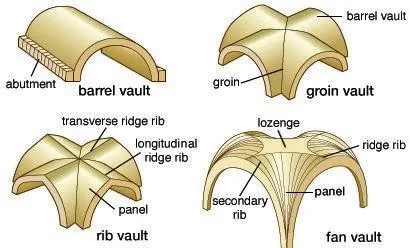
i) Use of columns
Columns were used both as functional and decorative architectural elements. Columns regularly featured in Roman temples and basilicas. In Roman temples, unlike the Greek ones, columns did not go around the temple’s main chamber; they were embedded in the walls along the sides and back of the chamber. The Romans used the Greek orders, Doric, Ionic and Corinthian, as well as the wholly-Roman Tuscan and Composite orders.

Doric Columns
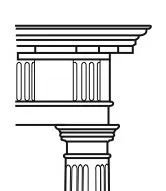
- Doric Style – Columns built in this style usually had no base and consisted of a massive shaft with 20 flutes. Doric architecture predates the 5th century BC. It was infrequently used, but examples are seen in the Parthenon and Coliseum in Rome. Later Roman columns differ from the Greek version in their addition of a base and changes in the capital profile.
Ionic Columns
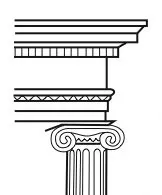
- Ionic Style – More visibly complex than that of the Doric style, being of slender proportion, and their height being generally about nine times the column’s lower diameter; the order is always used with a base and the column shaft usually has 24 flutings. The example is from the Temple of Portunus.
Corinthian Columns
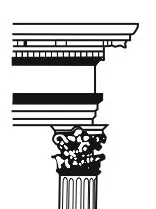
- Corinthian Style – This is the most ornate of the classical styles and is generally much more slender than the Ionic style. The Romans used the Corinthian order in numerous monumental works of imperial architecture. They gave it a special base, made carved additions to the cornice, and created numerous capital variations, utilizing florid leafage and sometimes human and animal figures. The prevailing form of Roman Corinthian is seen in the Maison Carrée in Nimes, France. This style originated after the 5th century BC.
Tuscan Column
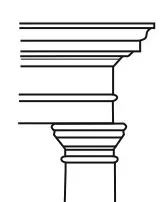
- Tuscan Column – The Tuscan column was the next form to be introduced and it was introduced by the Etruscans. The Tuscan Column is a very simple, plain column with a base and non-fluted shaft. No major examples of this architectural type survive today.
Composite
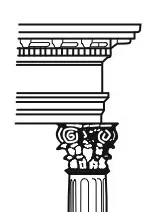
- Composite Order – The final architectural type to come from the classical world is the Composite order and it was first seen in 82 AD on the arch of Titus. The Composite form is a combination of Ionic and Corinthian orders. This form was the most complex due to the fact that it used the arch. Due to the advances of the Composite style of architecture and the skill that the Romans had with concrete, the Romans were able to develop such architectural marvels like the arch, the vault and the dome.
ii) Use of arches, vaults and domes
- The Romans wanted vast indoor spaces in which large numbers of people could comfortably congregate in, and so, to create these large unobstructed spaces, they replaced the old post and lintel system with the arch system.
- Using arches, vaults and domes, they were able to roof large public buildings like public baths, basilicas and temples.
iii) Use of elaborate interior decoration
- This was particularly veered in late Roman architecture. The decoration was usually non-structural and veered towards the ornate.
iv) Use of mosaics
- Mosaics were made of color stone chips set in cements and were used to decorate a wide range of private and public buildings.
- The Romans created intricate geometric designs, portraits, scenes and so on in mosaic.
4) Architectural buildings
- Unlike the Greeks, who seemed mainly interested in temple, theater and stadium architecture of comparatively small scale, the Romans had a penchant for imposing buildings and structures that would reflect the prestige, might and wealth of the Roman Empire.
- Such buildings and structures, erected in every corner of the Empire, were also meant to serve as unifying symbols for Roman citizens.
- Roman aqueducts were needed to supply water to the cities.
- Roman cities served as administrative hubs throughout the Empire. The cities usually had a forum and a basilica at the center and a protective city wall.
- Public places like the basilica, baths, libraries, temples and amphitheaters were created, respectively, to serve as administrative and public meeting places.
- To decorate public places and residences, the Romans created a variety of mosaics and murals.
- Triumphal arches were erected to commemorate Roman military victories.
Differences between Greek and Roman temples

- Various building types were built to suit their status and to meet their social and private needs.
- Best preserved example of a Roman temple is the Maison-Carree at Nimes, France.
i) Roman Temples
The Romans built both rectangular and circular temples, and there was much variety in their treatment.
Rectangular Temples: Temple of Mars, Venus, Saturn, at Rome; Temple of Jupiter, Temple of Bacchus at Baalbek, Temple of Diana at Nimes, Maison-Carree at Nimes, etc.
Circular Temples: Temples of Vista, the Pantheon at Rome, etc.
- In rectangular type the temples are usually twice as long as its width with a proto- type portico in front.
- In the rectangular temples a high podium, or basement, was substituted for the Greek stepped stylobate, and the prostyle plan was more common than the peripteral.
- The cella was relatively short and wide, the front porch inordinately deep, and frequently divided by longitudinal rows of columns into three aisles.
- In most cases the exterior of the cella in prostyle temples was decorated by engaged columns. A barrel vault gave the interior an aspect of spaciousness impossible with the Greek system of a wooden ceiling supported on double ranges of columns.
- In the place of these, free or engaged columns along the sidewalls received the ribs of the vaulting. Between these ribs the ceiling was richly panelled, or coffered and sumptuously gilded.
Maison-Carree, Nimes, France (c. 4AD)
- Built by Marcus Vispanius Agrippa (63-12 BC), son-in-law of Emperor Augustus (originally known as Octavian, heir of Julius Caesar).
- Dedicated to Gaius and Lucius Caesar, adopted sons of Augustus.
- Rectangular in plan; 25 m long by 12 m wide.
- Gable roofed, deep entrance porch and a frontal staircase giving access to its high platform or plinth.
- Built with 6 Corinthian columns: a strong influence of Greek temple style.
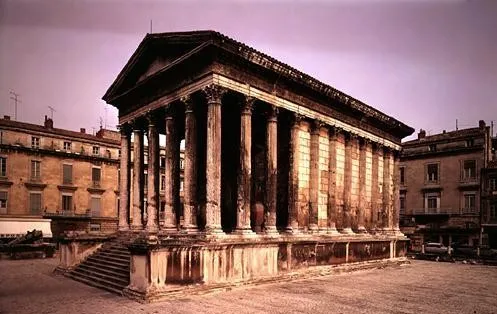
- The Romans also built many circular temples.
- Greatest surviving circular temple and the most important Roman building is the Pantheon, Rome.
Pantheon, Rome.
- Most preserved buildings of ancient Rome and one of the most significant buildings in architectural history.
- Begun in 27BC by the Roman general and statesman Marcus Vispanius Agrippa.
- Built to commemorate his victory over combined forces of the Roman general Mark Anthony and Cleopatra, queen of Egypt in the battle of Actium in 31BC by which Octavian became the first Roman emperor in 27BC and assumed the name Augustus.
- Begun as a rectangular temple measuring 44m wide and 22m deep with a gabled roof supported by a colonnade on all sides.
- Completely rebuilt by emperor Hadrian (Latin, Publius Aelius Hadrianus) (76-138AD), Emperor of Rome (117-138), between 118-128AD when it was converted to a rotunda of concrete faced with brick.
- Some alterations were made in the early 3rd century AD by the Emperors Lucius Septimius Severus (146-211), Roman Emperor (193-211) and his son, Caracalla (188-217)- original name is Bassianus and ruled as an Emperor with the name Marcus Aurelius Antoninus.
- It has a great concrete dome rising from the walls.
- Has a front porch of eight (8) Corinthian columns supporting a gabled roof with triangular pediment.
- Entrance porch is characterized by huge bronze double doors, 7m high (the earliest largest example of its kind).
- The dome was the largest built until the advent of modern architecture, measuring about 43m in diameter and rising to a height of 22m above its base and 43m from the ground.
- No external evidence of brick arch support inside the dome; exact method of construction not known.
- 2 major factors contributed to its success:
i.excellent quality of mortar used in the concrete
ii.careful selection and grading of the aggregates. - The temple’s immense circular space was lit solely by the 8m ‘eye’ or oculus; a revolutionary concept.
- Exterior is plain while the interior is lined with coloured marbles.
- The Pantheon was dedicated in 609AD as the church of the Santa Maria Rotunda.
Gallery of Pantheon, Rome.

ii) Roman Tomb
- Consisted of an earth mound (tumulus), surrounded by a ring of masonry rising usually to a considerable height.
- Most notable examples are the Tomb of Caecilia Metella on the Via Appia and Hadrian’s Tomb.
Hadrian’s Tomb (Castel Sant’ Angelo)
- Originally the mausoleum of Emperor Hadrian and, until Caracalla, the burial place of the Antonine Emperors.
- Antonine Emperor is the name of a dynasty of the five good emperors who reigned between 138-180 marked by a period of great internal peace and prosperity.
- Built 135–139 AD and converted into a fortress in the 5th century.
- The fort is a circle in plan surrounded by a square.
- Each corner of the square is protected by an individually designed barbican, or outwork.
- The central circle contains halls, chapels, apartments, courtyard, and prison cells.
- The castle served as a refuge in times of trouble in the Middle Ages, especially for the popes, who could reach it from the Lateran through a protected passage.
- Used as a prison until 1901, when its restoration was begun. Part of it is now a museum of military history.
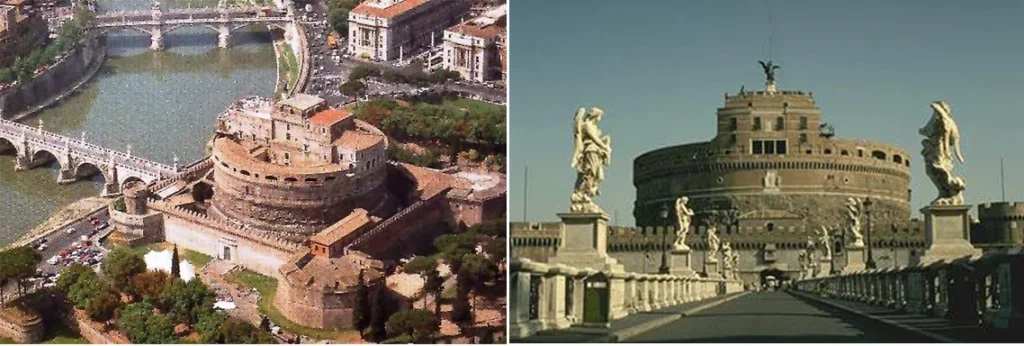
iii) Basilica
- A basilica in its earliest usage was a large covered public hall in ancient Rome and pre-Christian Italy used as a meeting hall, courthouse, banking, and for other commercial purposes.
- Usually flanked by side aisles set off by colonnades and with a raised platform at one or both ends.
- Used for judicial purposes in the 1st century, hence the raised platform became enclosed by an apse to accommodate the magistrate.
- Early Christians adopted it for their churches.
- Emperor Constantine commissioned the construction of three enormous Christian basilicas in Rome: St. Peter’s Basilica, Rome; S. Paulo fuori le Mura, and S. Giovanni, Laterano.
- The transept (a lateral aisle crossing the nave just before the apse) was added, thus creating the cross-shaped plan that became standard for churches in Western Europe throughout the Middle Ages.
- The columns separating the nave from the aisles in early Christian Basilica carried either arches or entablature which in turn, carries a blank wall supporting the timber roof of the nave.
- The nave rose higher than the side aisles, hence the wall that supports the nave roof stood above the level of the side aisle roof and could thus be pierced at the top with windows to light the center of the church.
- The high nave wall is called the clerestory wall and the windows pierced in them are called clerestory windows.
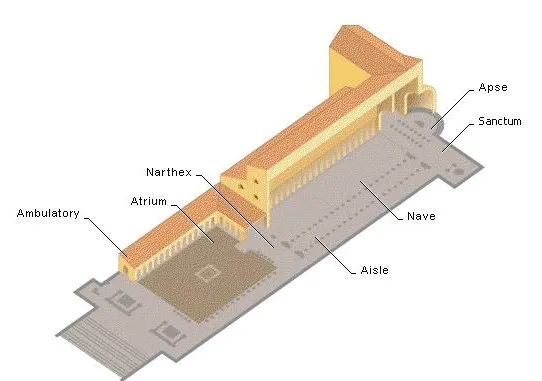
St. Peter’s Basilica, Rome.
- Constantine, the first Christian emperor of Rome, built the Old St. Peter’s Basilica in 326AD on the Vatican Hill; this gave official recognition to the hill.
- Vatican City comes from the name of the Vatican hill on which it is located.
- This was the place where St. Peter, the chief apostle of Jesus Christ was crucified and buried around 64AD.
- Gradually, houses and palaces were built on the hill and from the 13th century, popes made the Vatican their official residence.
- In the mid-15th century, the Old St. Peter’s started falling into ruins and Pope Nicholas V ordered the reconstruction and the enlargement of the church after plans by architect Bernado Rossellino.
- After the death of Pope Nicolas V, Donato Bramante was appointed by Pope Julius II in 1506 as the chief architect of the new basilica.
- Bramante initiated the basilica design as a Greek cross plan with a massive central dome.
- At the death of Bramante in 1514, artists such as Raphael, Fra Giacondo de Verona, and Giuliano da Sangallo, modified the original Greek cross plan to a Latin cross with three aisles separated by pillars.
- In 1546/7, Pope Paul III commissioned Michelangelo who designed the imposing dome and reverted the plan back to the Greek cross plan.
- Michelangelo died in 1624, two years before the completion of the dome.
- Carlo Maderno under order from Pope Paul V, again exchanged the Greek cross for the Latin cross by extending the nave to the east, thus completing the 187m long main structure.
- The basilica was finally dedicated by Pope Urban VIII in 1626.
- The basilica includes 45 altars decorated by many famous artists and is now a tourist attraction.
- The interior can be visited daily free although a strict dress code is applied.
- The dome can also be visited although entrance is not free but worth it.
- There is an option of taking the elevator or the stairs, the stairs being cheaper.
- From the top of the dome, there is a magnificent view of Rome and of St. Peter’s Square in particular.
- It was the largest church in the Christiandom until surpassed in 1989 by the newly built basilica in Yamoussoukro, Côte d’Ivoire.
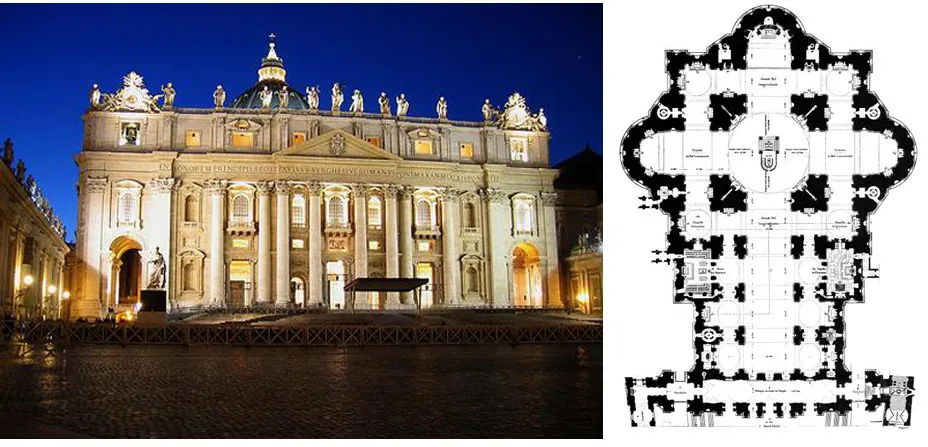
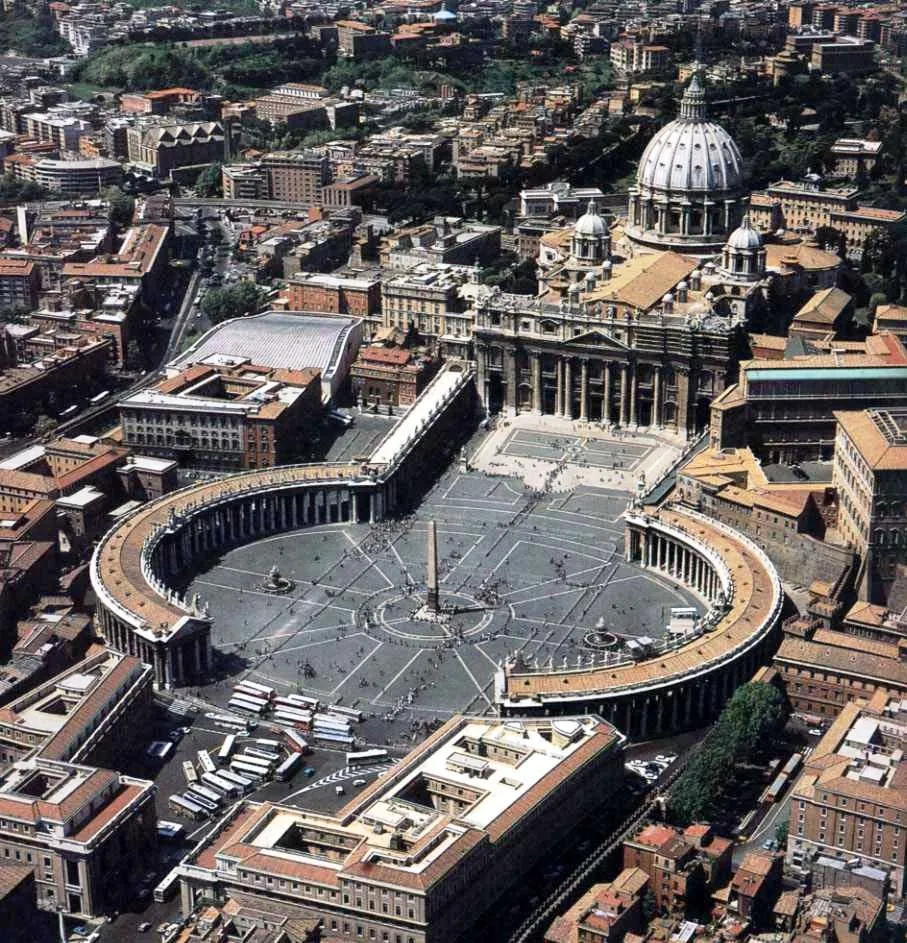
iv) Public Baths
- With the water system that the Aqueduct allowed, the Roman public baths got more sophisticated and grew in size as time went on.
- The great roman baths – 950 baths have been found in all.
- The bath of diocletion (298 – 306 ce) is built on 50 acres of land having a capacity of 3,000 people at any given time. It has various baths:
The caladurium (tepid water bath)
The tepidarium (warm water bath)
Frididarium (cold water bath)
Natatio (open air swimming pool)
- Built to provide facilities for communal or private washing and bathing.
- Made up of a large open garden surrounded by suite of dressing rooms and a block of bath chambers with apodyterium (changing room), laconium (steam bath), hot room (caldarium), warm room (tepidarium), and cold room (frigidarium).
- Service was furnished by means of underground passageways, through which slaves could move swiftly without being seen.
- Clerestory windows were used for lighting the roofing of the enormous rooms.
- Imperial baths were built for the pleasure of the leisure classes and became a recognized feature of Roman life.
- Facilities include gymnastic exercise halls and halls for philosophers, poets and those who wish to hear them gathered.
- Best preserved are the Baths of Caracalla and those of Diocletian (c.298-306AD), with accommodation for 3200 bathers.
Baths of Caracalla, Rome
- Begun by Emperor Septimus Severus in 206AD and completed by his son, the Emperor Caracalla in 217AD.
- Amongst Rome’s most beautiful and luxurious baths designed to accommodate about 1600 bathers.
- Consisted centrally of a block of large, vaulted bath chambers covering an area of 230m long by 115m wide, with courts and auxiliary rooms, surrounded by a garden with space used for exercises and games.
- There were three main bath chambers: the frigidarium (cold room), tepidarium (tepid room) and the caldarium (hot room).
- There were also large open-air swimming pools.
- Marble was used lavishly, and sculpture, mosaics, frescoes and other decorations ornamented the interior.
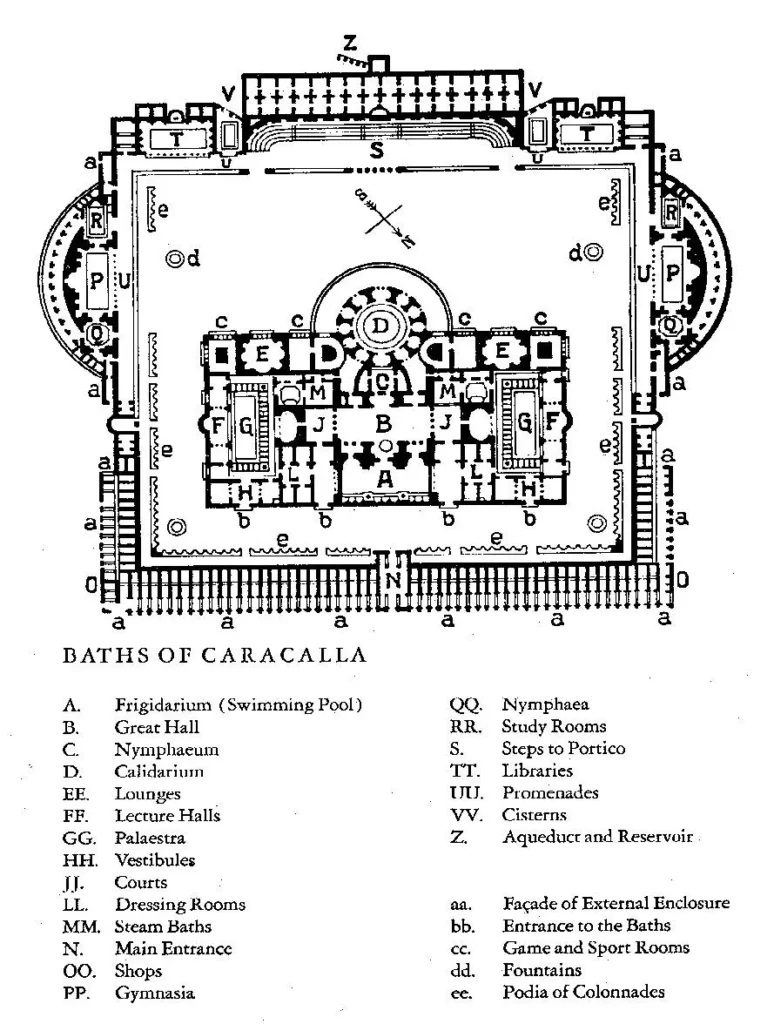

v) Roman Theatre
- Roman theatre differed in several respect from those of the Greeks.
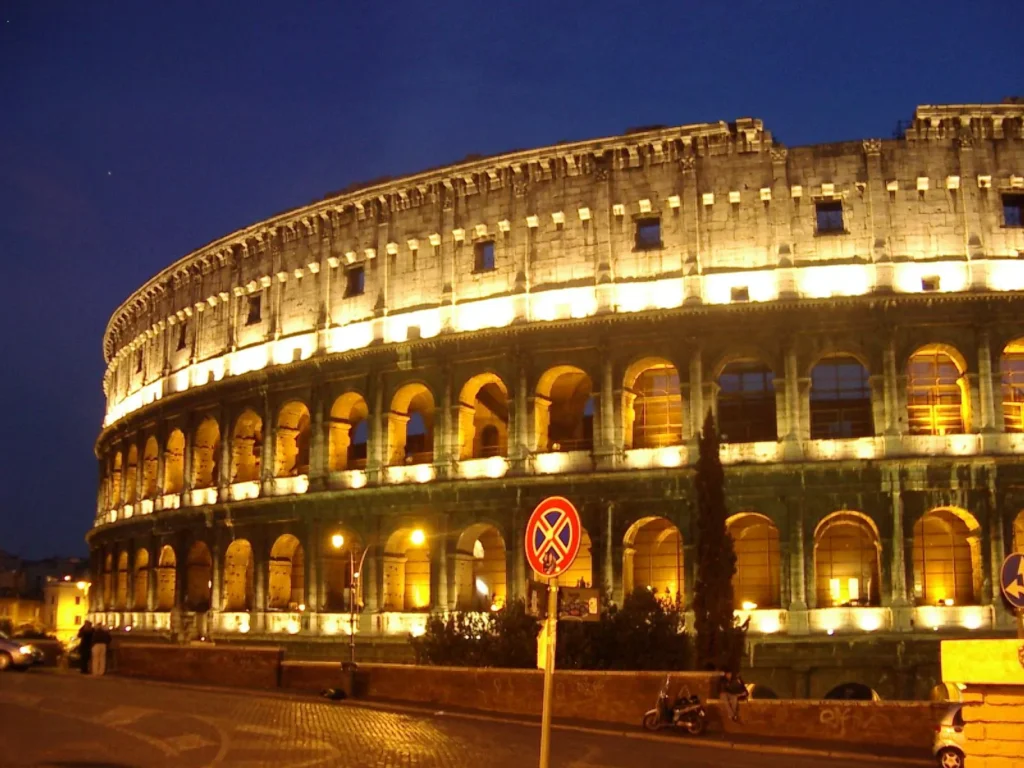
Concepts behind the evolution of the Roman free standing theatre;
- Etruscan’s dancers and musicians in 364BC brought temporary wooden stands for the spectators, and the stands later developed into the Roman auditorium, built up entirely from the level ground.
- They also brought to perfection the principles of barrel and cross vaulting, penetrating the seat bank at regular intervals with vomitoria (exit corridors).
- The theatre was roofed and the number of entrances to it was increased to five; three, as before, in the wall at the rear of the stage and one at each side.
- As every seat had to have a view of the stage, the area occupied by the seating (cavea) was limited to a semicircle.
- During the Roman Empire, civic pride demanded that all-important cities have theatres, amphitheatres, and a small, permanently roofed theatre as well.
vi) Amphitheatres
- Free-standing building of round or oval shape with a central area (the arena), and seats concentrically placed around it.
- Amphitheatre is a Greek word meaning ‘theatre with seats on all sides’.
- Suitable for the entertainment that these people cherished – gladiatorial games and venationes.
- Most Roman amphitheatres were constructed with elaborate labyrinth below the arena.
- The passages included media way for scenery, elevators spaces and machinery that lifted the animals and stage sets, and rooms for the gladiators, were ingeniously arranged to connect by means of many trapdoors, with the arena above.
- The spectators seats run around the arena, and its separated from it by high wall topped by a metal screen.
- Spectator seats are divided by passageways running around the amphitheatres into several sections (maeniana).
- The lowest section or podium has a special box for the emperor and his retinue; other distinguished guests, ambassadors, priests, consuls and vestal virgins are seated on the opposite side of the emperor.
- The rest of the first gallery contained seats for senators and those of the equestrian rank.
- The second gallery was reserved for patricians, the third for plebeians, and the fourth or uppermost gallery, for women.
- An awning (velarium) was manipulated by sailors to shelter the spectators from the sun.
- Each of these galleries was divided into wedged-shaped sections (cunei) by radial walks that led to the many exits (vormitoria).
- The largest and the most important amphitheatre of Rome was the Colosseum.
Colosseum, Rome
- Used for training warriors and also to hold contests between men and animals to serve the popular amusement.
- Originally called Flavian Amphitheatres because it was built under the Flavian Emperors but later changed to Colosseum because of the colossal statue of Nero that stood beside it.
- Built by the Emperor Vespasian, and his sons – Titus and Domitian in about 70-80AD.
- Officially dedicated in 80AD by Titus in a ceremony that included 100 days of games.
- It was considered a great architectural and engineering feat for the following reasons:
a) Free-standing, multi-level structure of stone and concrete.
b) Grandeur in scale and decoration
c) Its layout facilitated both the production of extravagant spectacles
d) Crowd control of the large numbers of people attending the events
- External measurement is 190m by 155m and the outer façade is roughly 48.5 m high.
- It has three tiers of arches of superimposed columns—Tuscan capitals on the first level, Ionic on the second, and Corinthian on the third—and an upper level of Corinthian pilasters and small square windows.
- Seating capacity for 50 000 spectators
- 80 entrances so arranged that the building could be cleared quickly.
- Built of concrete and stone, the exterior faced with travertine and the interior with precious marbles.
- Tiered seating offered a better view of the games for a greater number of people.
- Scene of thousands of gladiatorial contests, contests between men and animals, and mock naval battles.
- Also used for staged battles between wild beasts (lions) and Christians among other spectacles.
- Stage of the arena was made of wood which was covered with sand to absorb the blood of wounded gladiators and wild beasts.
- The Colosseum was damaged by lightning and earthquakes in medieval times and, even more severely, by vandalism; all the marble seats and decorative materials have disappeared.
- A restoration project was undertaken in the 1990s.


vii) The Circus
- The circus was the Roman version of the Greek hippodrome and consisted of a long circuit for chariot races.
- It was essentially a racecourse lined with tiers of seats along all sides of the arena except at one end where the stalls for the horses and chariots were located.
- The opposite end is squared-off and provided with arrangements for chariots to enter and draw up for the start.
- There is a barrier in the middle on which judges and referees might perform their functions.
- The circus was also used for spectacles other than racing such as, traditionally, the burning of Christians by Emperor Nero.
- The largest and doubtless the finest ever built was the Circus Maximus in Rome.
Circus Maximus, Rome.
- It was the largest of the Roman hippodromes and one of the largest sport arena ever built.
- A U-shaped structure with seats on three sides and a low wall, the spina, running down the middle of the arena around which the chariots raced.
- It was built around 600BC and rebuilt in the time of Julius Caesar (1st century BC) to seat an estimated 150 000 spectators.
- It was enlarged by later Emperors until it reached a maximum size under Emperor Constantine (4th century BC) of external dimension of about 610m long and 190m wide, with a seating capacity of about 250000, greater than that of any subsequent stadium ever built.
viii) Triumphal Arches
- They were erected to commemorate an important event or campaign.
- They were often isolated rather than built to span a roadway.
- The triumphal arch was usually decorated with columns and bas-reliefs of the chief events it commemorated and was frequently surmounted by sculpture.
- Its basic form consisted of two piers connected by an arch and crowned by a superstructure, or attica, that served as a base for statues and bore commemorative inscriptions.
- The function of the arch, therefore, seems to have been that of an honorary monument of unusual importance.
- The most important of these arches are the Arch of Titus (Arco di Tito) c. 81AD, commemorating the capture of Jerusalem, and the Arch of Septimus Severus (c. 203AD) and the Arch of Constantine (c. 315AD).
Arch of Titus, Rome
- Erected by Domitian in honour of his father Emperor Vespasian and brother, Titus around 81AD.
- It was built to commemorate their victories in the Judean War and the conquering of Jerusalem by Titus in 70AD.
- Tradition says that not even one Jew ever passed under the arch, unwilling to pay homage to those who destroyed their temple.
- Relieves on it shows the triumphal procession bringing the spoils from Jerusalem.
- In the center of the vault is the statue of Titus, who is mounting the eagle.
- The arch is 15m high and 13.5m wide.
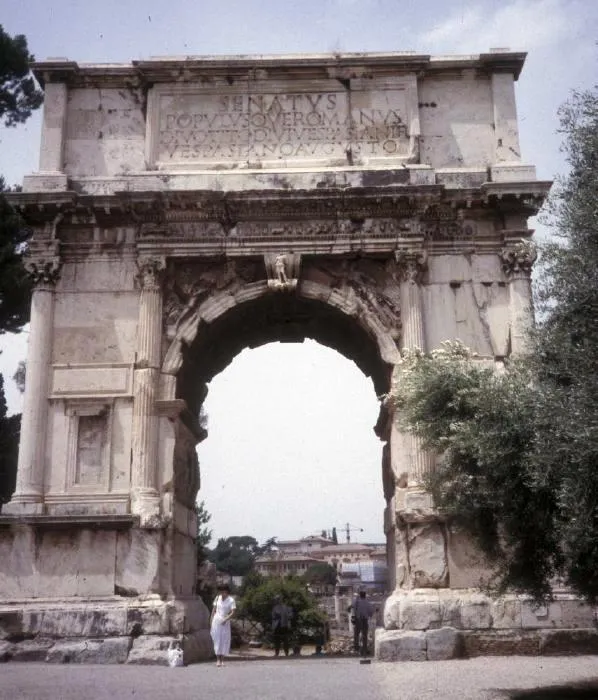
ix) Monumental City Gate
- Just like triumphal arches, they sometimes serve a commemorative purpose.
- However, they differ from triumphal arches because they serve as part of the defenses of the city.
- The most famous are the Porta Nigra at Trier in Germany and the gate from Miletus in Turkey.
x) Bridges
- The bridges of the Romans ranked among their greatest monuments.
- The Romans began organized bridge building to help their military campaigns.
- The discovery of pozzolana, a natural cement aided the Romans in building piers in rivers.
- Roman bridges are characterized by the use of the circular arch form.
- The circular arch allowed for spans much longer than stone beams, and for bridges of more permanence than wood.
- For longer bridges which necessitate the use of several arches, the building of stronger piers was critical.
- To build a strong pier, it has to be built on bedrock, which is a problem in a wide river with a soft bed.
- The Romans developed the cofferdam – a temporary watertight enclosure made from wooden piles driven into the river bed to make a sheath, which was often sealed with clay, from which water is pumped to expose the bed of a body of water in order to permit the construction of a pier or other hydraulic work.
- Concrete was then poured into the water within the ring piles.
- Most surviving Roman bridges were built on rock, but the Sant’Angelo Bridge in Rome stands on cofferdam foundations built in the Tiber River about 1800 years ago.
xi) Aqueducts
- Aqueducts (Latin aqua, ‘water’, and ducere, ‘to lead’) are man-made conduit for carrying water.
- They are artificial structures built to transport water across a hollow or valley.
- In modern engineering, ‘aqueducts’ refers to a system of pipes, ditches, canals, tunnels, and supporting structures used to convey water from its source to its main distribution point.
- The elaborate aqueducts system that served the capital of the Roman Empire however remains a major engineering achievement.
- From 312BC to 226 AD, eleven aqueducts were built to bring water to Rome, some from as far away as 92km.
- Only a portion of Rome’s aqueducts system actually crossed over valleys on stone arches, the first being the Aqua Marcian in Rome, which is about 90 km long and built by the praetor Marcius in 144BC.
- Majority of the system consisted of underground conduits made mostly of terracotta pipe, leather, lead and bronze.
- Water flowed to the city by force of gravity alone and usually went through a series of distribution tanks within the city.
- Rome’s famous fountains were also supplied in this way.
- The surviving aqueduct monument is the Pont du Gard aqueduct near Nimes in southern France, completed in 14 AD.
- The structure was built to channel water from from a spring 50km from Nimes and have three tiers of semicircular arches, with the top tier rising more than 48m high above the Gard River.
- Roman aqueducts were built throughout the Roman Empire in Greece, Italy, France, Spain, North Africa and Asia Minor.
- As central authority fell apart in the 4th and 5th centuries, the systems also deteriorated.
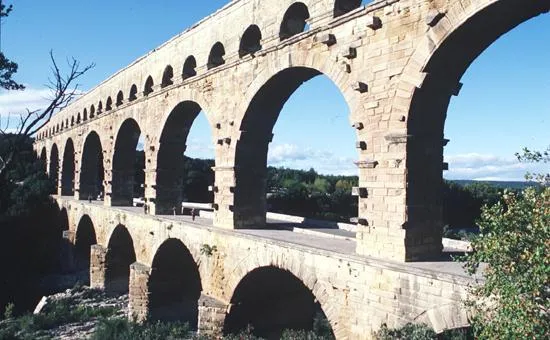
The aqueduct known today as the Pont du Gard was built in the 1st century BC. Water, tapped from a local spring to supply the Roman city of Nîmes, flowed along the topmost tier of arches. It is considered to be the greatest of all aqueducts, and in 1985 it was inscribed on the UNESCO World Heritage list

Roman Aqueduct
Aqueducts, which brought water from mountain springs to the cities, were supported by huge arches made of stone blocks held together with cement. Teams of labourers were able to lift heavy stones into place with the aid of pulleys and cranes that were powered by wooden treadmills. Once the water reached a city, it was stored in basins and tanks and then distributed by an elaborate system of underground pipes for drinking, as well as for public baths and lavatories.
Overall, Roman architecture had a lasting impact on the world of architecture, and its influence can be seen in many buildings and structures throughout the world today.